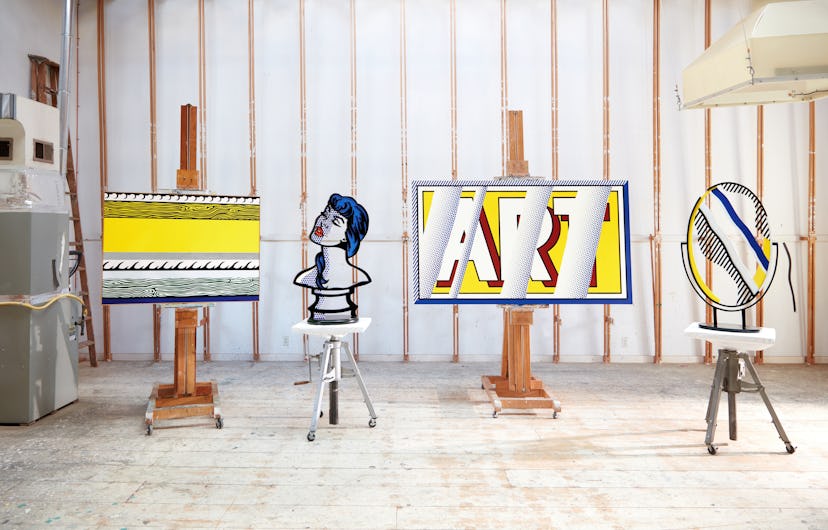Sotheby’s Upcoming Roy Lichtenstein Auction Goes Beyond Pop Art

There’s one piece in the range of 43 Roy Lichtenstein works up for auction at Sotheby’s that feels out of place. Among the thousands of Ben Day dots, exacting lines, and clear subjects associated heavily with the artist and his Pop Art style sits an abstract, expressionist oil painting that looks to have been completed by an entirely different creator.
“We have never seen something like this in the market,” says David Galperin, vice chairman and head of contemporary art at Sotheby’s New York, of the untitled piece created by Lichtenstein in 1960. “Nobody would necessarily recognize who this is. It’s Lichtenstein pre-Pop.” Untitled looks more like a Franz Kline or Willem De Kooning, with crazed lines slashed in all directions across the canvas. The Lichtenstein colors are there—primary hues and stark whites—but they blend together in a way not usually seen within the artist’s later work. Lichtenstein created Untitled just a year or two before he’d found his footing in Pop. It’s an example of the breadth Sotheby’s is able to represent with its latest auction of Lichtensteins, which spans four decades and numerous mediums.
Roy Lichtenstein, Untitled, 1960.
The impressive scope is obvious upon stepping into the gallery at Sotheby’s New York offices, where the pieces are being held ahead of the auction on May 15 and 16. The first room alone houses drawings, paintings, collages, and sculptures (both wood and bronze) by Lichtenstein. A turn around the corner expands upon the selection with some prints as well.
“We came up with a selection we thought would be exciting for collectors at all levels,” says Mitchell Lichtenstein, actor, writer, director, and son of the artist. Sotheby’s worked with the Lichtenstein Estate to put this auction together. Mitchell, specifically, is excited for potential bidders to see Untitled, but also the other pieces that demonstrate his father’s hand. Most of the elder Lichtenstein’s art reaches a level of perfection that erases him completely from the process, which was “the whole idea,” according to his son. But works like Untitled, various drawings, and other early paintings reveal that human touch.
“The sketches really show him,” Mitchell tells W. “You feel his presence a lot more, which personally is what I want more than anything and what I miss.”
Of course, along with those sketches and studies are the classic Lichtenstein oil paintings, which render Monet’s Haystacks in a series of black, white, and yellow dots or depict interiors that look remarkably similar to the rooms that likely already hold a Lichtenstein of their own.
Roy Lichtenstein, Haystacks, 1968.
“It’s super exciting for us to be able to tell the whole story of an artist,” says Galperin. It helps that Lichtenstein was incredibly prolific, churning out art fairly regularly for over four decades. And of course, his practice did undergo changes during that time, but Mitchell is hesitant to call it an evolution.
“When he found this voice in the early ’60s, it was so clear that it didn’t need to evolve because he found endless ways of applying it.” He used it to comment on important issues like gun violence and the atomic bomb—two explorations available in Sotheby’s offerings. And then there’s his Mirrors series, a favorite of Mitchell’s and also represented in the auction.
Roy Lichtenstein, Mirror 1, 1976.
“I think the Mirrors are really beautiful,” he says. “They’re not only compositionally beautiful, but it’s a funny idea to have something that’s only purpose is to reflect—and of course it does not reflect anything. It’s amusing when you think about it.”
Humor is a theme found throughout Lichtenstein’s portfolio, perhaps most obviously on display in the up-for-auction Stretcher Frame with Cross Bars III. Lichtenstein never shied away from making art about art, as seen in his many works that placed himself in conversation with the modern masters by recreating Monets, Calders, Picassos, and more iconic pieces (Haystacks, for example) in his own, unique style. Stretcher Frame adds a touch of humor to this idea, while also providing a “behind-the-scenes” look at art making.
Roy Lichtenstein, Stretcher Frame with Cross Bars III, 1968.
It’s an intellectual kind of funny—one that’s present not only in Lichtenstein’s practice but his personality, too. “He didn’t tell jokes or do funny things exactly,” Mitchell recalls, instead choosing the terms “wry and ironic” to describe his father. “Modest and humble” also come up.
Galperin is more effusive: “He is the lifeblood of the market,” he says of the artist. “He is universally beloved, one of the great titans of the 20th century.” And despite his passing almost 30 years ago, he remains resonant with collectors around the world. It’s because of this that Sotheby’s and Galperin expect big things from the sale. Last season, they put up 15 of the artist’s works, with a majority of them selling over the high estimates. So while Mitchell admits his family would “love to keep everything” his father ever produced, it should come as no surprise that he, too, is happy for these 43 pieces to find new homes.